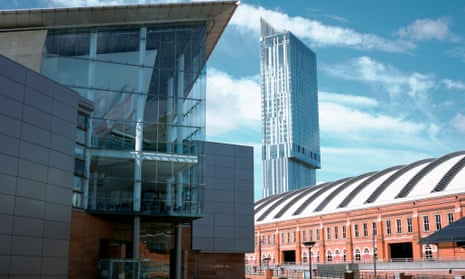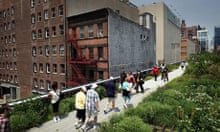Most city-dwellers are big fans of green spaces, with the benefits to health and community well-being evident in the data. There's more to it though - adding more commons, parks and greens could also shelter British cities from the full effect of global warming.
Since the beginning of the 20th century global temperature has increased by 0.8C (1.44F), with two thirds of warming occurring since 1975. Temperature increase from now until 2050 is expected to be increasingly rapid, with human activity the dominant cause of warming.
Climate change is set to bring hotter, drier summers over the next three decades with urban dwellings - already generally warmer than rural areas - due to take the brunt. This is because roads, pavements and buildings absorb a relatively high amount of heat.
As Britian gets hotter, this 'urban heat island effect' will bring with it extra drought and extended periods with high temperatures for our cities.
By 2050 the extreme readings associated with current heatwaves are expected to be the norm while by the end of the century they may even seem mild.
How could green space reduce the impacts of climate change?
The data highlights that an increase in green spaces within UK cities, including trees, parks, gardens, green roofs and waterways, could help to combat future increases in temperature.
This is despite the fact that, at least in England, there has been a relatively drastic cut in the financial support for England's parks and open spaces.
Focusing upon Greater Manchester, one of the most populous city in the UK, a10% increase in green space could keep temperatures at or below present levels into the 2050s, despite a changing climate.
This article includes content provided by Google. We ask for your permission before anything is loaded, as they may be using cookies and other technologies. To view this content, click 'Allow and continue'.
Across Greater Manchester on average, the temperature will increase by 1.4C (2.5F) from baseline to 2050 as a result of climate change, from 21.8C (71.24F) to 23.2C (73.8F). This is a substantial rise of over 6%. The map above shows how the temperature would expect to increase within the city currently.
An increase of 10% in cooling green space within the city over the same period could maintain temperatures at existing levels, with temperature only increasing by 0.1C (0.18F) 2050. The map below shows the change in temperature if green space within the city increased as described previously.
This article includes content provided by Google. We ask for your permission before anything is loaded, as they may be using cookies and other technologies. To view this content, click 'Allow and continue'.
It may even substantially reduce temperatures. If it was implemented there is a predicted decrease of 1.5C (2.7F) in the city centre of Manchester for 2050 where existing green space is lowest.
Investment in green space within urban areas in the UK could help to prevent the expected discomfort, health risks and increased mortality associated with rising summer temperatures in the UK.
Current and forecasted temperatures for Greater Manchester
The map below shows the baseline temperature (average for 1961-1990) for Greater Manchester. The second map shows the forecasted temperatures for 2050.
The temperature data used is from the UK Climate Projections 2009 (UKCP09) which are designed to help communities to adapt to climate change. The projections have been continuously updated with evolving climate science.
This article includes content provided by Google. We ask for your permission before anything is loaded, as they may be using cookies and other technologies. To view this content, click 'Allow and continue'.
It uses the most likely of the UK climate projections for 2050, a 'high emissions scenario' with a 50% probability. This is compared to average or 'baseline' temperatures for the period 1961-1990. The temperature values are summer temperatures that will occur on the two warmest days of the year.
This article includes content provided by Google. We ask for your permission before anything is loaded, as they may be using cookies and other technologies. To view this content, click 'Allow and continue'.
The data was generated using the STAR Tools, a tool developed by the University of Manchester and The Mersey Forest available and can be used to generate similar data for other locations in the UK.
This article was amended on May 22. It previously miscalculated the fahrenheit change. All figures shown should now be correct.
More open data
Data journalism and data visualisations from the Guardian
Development and aid data
Search the world’s global development data with our gateway
Can you do more with this data?
Contact us at data@theguardian.com
Follow us on Twitter
Like us on Facebook




Comments (…)
Sign in or create your Guardian account to join the discussion